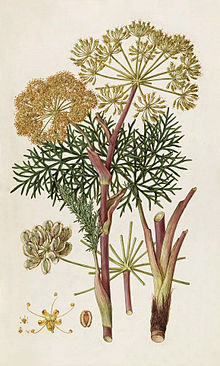Thapsia(plant)
| Thapsia | |
|---|---|

| |
| Thapsia garganica | |
| Scientific classification | |
| Kingdom: | Plantae |
| Clade: | Tracheophytes |
| Clade: | Angiosperms |
| Clade: | Eudicots |
| Clade: | Asterids |
| Order: | Apiales |
| Family: | Apiaceae |
| Subfamily: | Apioideae |
| Tribe: | Scandiceae |
| Subtribe: | Daucinae |
| Genus: | Thapsia L. |
| Synonyms[1] | |
| |
Thapsia,commonly known as thedeadly carrots,[2]is a smallgenusofpoisonous plantsin the familyApiaceae.Their center of diversity is around the westernMediterranean,extending into theAtlantic coastsofPortugalandMorocco.Some species are used intraditional medicine.[3]
Description
[edit]Species ofThapsiaare herbaceous perennials, growing 50 to 200 cm high. The inflorescences are large, regularly distributed umbels. The seeds have four wings, and are the main characteristic of the genus, which is distributed in the Mediterranean, on the Iberian peninsula, and North Africa.
Thegeneric nameThapsiais derived from theAncient Greekname θαψία (thapsía) for the members of the genus. The Greeks believe it to have originated from ancientThapsosinSicily.[4]It has a long history of being used in ancienttraditional medicine.Algerians used it as a pain-reliever though they recognized that the plant was deadly tocamels.The Greek colony ofCyreneexported a medicinal plant known assilphion,used as apurgativeandemetic.Although its exact identity remains contentious today, some historians believe that the plant may have beenThapsia garganica.[5]
Cancer research
[edit]The chemical compoundthapsigarginhas been isolated fromThapsia garganica.A syntheticprodrugof thapsigargin called "G-202" is in preliminary clinical trials for cancer treatment.[6]The active constituent kills tumor cells by destroying their calcium balance. A biotech company called GenSpera, Inc. in San Antonio, TX is studying methods of delivering thapsigargin directly to cancer cells, avoiding damage to other cells in the body of the patient.[7]
Antiviral research
[edit]This same chemical compoundthapsigarginis now being looked at as an antiviral to use against SARS-coV-2, the coronavirus virus that causes COVID-19. It has not yet reached the clinical trial stage.[8]
Species
[edit]20 species ofThapsiaare currently accepted.[9]It is, however, a complex genus, and some authors may recognize different numbers of species.[4][10]
- Thapsia asclepiumL.
- Thapsia cinereaA.Pujadas
- Thapsia eliasii(Sennen & Pau) Wojew., Banasiak, Reduron & Spalik
- Thapsia foetidaL.
- Thapsia garganicaL.
- Thapsia gummifera(Desf.) Spreng.
- Thapsia gymnesicaRosselló & A.Pujadas
- Thapsia maximaMill.
- Thapsia meoides(Desf.) Guss.
- Thapsia minorHoffmans & Link
- Thapsia nestleri(Soy.-Will.) Wojew., Banasiak, Reduron & Spalik
- Thapsia nitidaLacaita
- Thapsia pelagicaBrullo, Guglielmo, Pasta, Pavone & Salmeri
- Thapsia platycarpaPomel
- Thapsia scabra(Cav.) Simonsen, Rønsted, Weitzel & Spalik
- Thapsia smittiiSimonsen, Rønsted, Weitzel & Spalik
- Thapsia tenuifoliaLag.
- Thapsia thapsioides(Desf.) Simonsen, Rønsted, Weitzel & Spalik
- Thapsia transtaganaBrot.
- Thapsia villosaL.
Gallery
[edit]References
[edit]- ^"Thapsia L. | Plants of the World Online | Kew Science".Plants of the World Online.
- ^M. Seoane (1831).Neuman & Baretti's Dictionary of the Spanish and English Languages.William Clowes.
- ^S. Iadjel; A. Zellagui & N. Gherraf (2011)."Reinvestigation of essential oil content ofThapsia garganicagrown in the east of Algeria "(PDF).Revue des Sciences fondamentales et appliquées.2:30–34.
- ^abS. Castroviejo; et al., eds. (2003).Flora Iberica. Volume X: Araliaceae-Umbelliferae(PDF).Real Jardín Botánico. pp. 401–410.ISBN8400081501.
- ^M. Grieve."Thapsia".Botanical.RetrievedAugust 26,2012.
- ^"Thapsigargin prodrug G-202".NCI Cancer Dictionary.
- ^Kristen Philipkoski (2 February 2012)."Scientists Transform Deadly Plant Into Cancer Killing Smart Bomb".Gizmodo.
- ^David Nield (27 November 2021)."Molecule Derived From Poisonous Plant Blocks All SARS-CoV-2 Variants in Cell Cultures".ScienceAlert.
- ^"ThapsiaL. "Plants of the World Online.Royal Botanic Gardens, Kew.Retrieved10 September2024.
- ^Pujadas-Salva, A. J.; Plaza-Arregui, L. (2003)."Studies onThapsia(Apiaceae) from north-western Africa: A forgotten and a new species "(PDF).Botanical Journal of the Linnean Society.143(4): 433.doi:10.1111/j.1095-8339.2003.00233.x.


